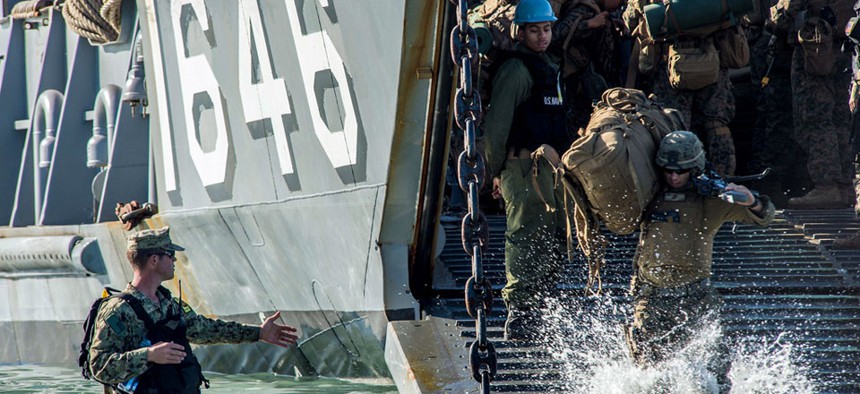U.S. and Australian Troops Relied on Internet Chat Rooms to Conduct Joint Exercise

Marines from the 31st Marine Expeditionary Unit land on the beach aboard Landing Craft Utility 1646 during a beach assault in support of Talisman Saber 2013. US Navy
Backpack satellite radios also played a key role.
Navy and Marine Corps units participating in the recent joint Talisman Saber exercise in Australia relied on Internet chat rooms and portable satellite radios for operational command and control.
The USS Blue Ridge, command ship of the 7th Fleet, controlled the exercise while the USS Bonhomme Richard, an amphibious assault ship, launched helicopters and tilt-rotor MV-22 Ospreys off its flight deck and amphibious vehicles from its well deck. The operation, which ran from July 15 through Aug. 5, included 18,000 U.S. and 9,000 Australian military personnel.
The ships, along with the aircraft carrier USS George Washington, operated off the northeast coast of Australia with Marines conducting operations ashore in partnership with Australian Army units near Townsville.
The Blue Ridge packs six powerful satellite communications systems connected to seven onboard networks, which in normal operations feed information to 600 unclassified, 450 secret and 50 top secret terminals. The satellite systems provide a combined uplink throughput of 20 megabytes per second and 116 megabytes per second downlinks.
During Talisman Saber, the ship took on another 300 personnel, including 92 Australians. Capt. Susan BryerJoyner, 7th Fleet assistant chief of staff for communications, said in a telephone interview from the Blue Ridge that she beefed up the network with 22 unclassifed, 37 secret and seven top secret workstations along with 50 thin clients running the Combined Enterprise Regional Information Exchange System, known as CENTRIX, for use by Australian personnel.
Plain vanilla Internet chat stands out as the “favorite tool” for communications on the Blue Ridge and among ships and forces under its control, BryerJoyner said, noting “it’s quick and easy” with battle watch standers communicating through chat rooms dedicated to their area of interest.
The Blue Ridge also features five secret and two top secret video teleconferencing (VTC) suites. Joyner said Vice Adm. Scott H. Swift, 7th Fleet commander, used VTC on a twice daily basis to discuss face-to-face the battle rhythm of the exercise with his subordinate commanders and Australian counterparts.
BryerJoyner said that the Blue Ridge also used a technology for secure voice communications just approved for use aboard ships, Voice Over Secret Internet Protocol, developed by the Defense Information Systems Agency.
Australian Brig. Gen. David Coghlan said "We've brought together members of the army, navy and air force from around Australia and in some cases from places from around the world to join the Blue Ridge."
Coghlan, the exercise deputy commander, said, "The intricacies of coming aboard a U.S. Navy command and control ship have been challenging, but really useful and worthwhile." He added, "The level of integration with the U.S. is unprecedented and we appreciate it."
On the Bonhomme Richard, Maj. Todd O’Brien, communications officer for the 31st Marine Expeditionary Unit, said the 2,000 Marines participating in the exercise primarily relied on satellite voice communications provided by Harris Corp.’s AN-PRC 117F backpack radios, which weigh just under 10 pounds. Maj. Todd O’Brien, the unit’s communications officer, said in a phone interview from the ship that the Marines deployed roughly 60 of these backpack radios during the exercise, which used the Navy UHF satellite fleet for communications with Marine and Australian units.
O’Brien said the exercise proved a real test of the 31st Marine Expeditionary Unit’s communications capabilities as it involved amphibious landings and then a push far inland “with multiple scenarios going on at once.”
The main infantry unit in the exercise, 2nd Battalion, 4th Marines relied on VHF-FM Single Channel Ground and Airborne Radio System for communications between its headquarters and individual companies, O’Brien said.
During the exercise, the Marines also used HF terrestrial radios, but O’Brien said today’s Marines are rusty on the skills needed to use such gear compared to their predecessors.
The Marines started stationing troops in Darwin, Australia, in April 2012 as part of a renewed Defense Department focus on the Asia-Pacific region. O’Brien said the Talisman Saber exercise “strengthened our ties with the Australian forces.”
Correction: The initial version of this story misspelled Capt. Susan BryerJoyner's name.



